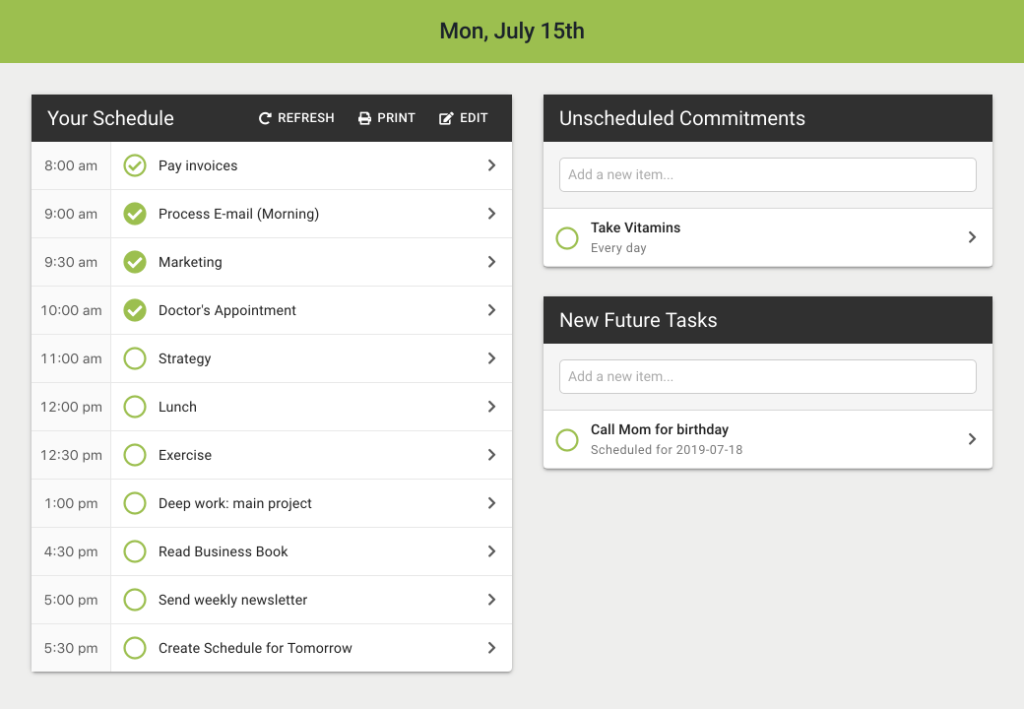Are you tired of feeling like your ADHD is constantly sabotaging your productivity? Do you find yourself easily distracted, struggling to focus, and overwhelmed by the sheer number of tasks on your to-do list?
If so, you’re not alone. Many individuals with ADHD face these challenges on a daily basis, making it difficult to accomplish their goals and reach their full potential.
But fear not, because there is a solution that can help you take control of your time and improve your focus: time blocking.
This powerful technique has been proven to be effective for individuals with ADHD in providing structure, reducing overwhelm, and enhancing productivity. By implementing time blocking into your daily routine, you can finally regain control of your time and accomplish more with greater ease.
In this ultimate guide to mastering time blocking for ADHD, we will explore exactly why this technique is so beneficial for those with ADHD, how it works, and most importantly, how to do it properly.
The Benefits of Time Blocking for ADHD
Time blocking is a game-changer for individuals with ADHD. By allocating specific blocks of time to different tasks and activities, you can create structure and order in your day, which is essential for managing ADHD symptoms.
Here are some of the key benefits of time blocking for ADHD:
- Enhanced Focus
One of the biggest challenges for individuals with ADHD is maintaining focus on a single task. Time blocking helps by providing a clear roadmap for your day, allowing you to prioritize tasks and allocate dedicated time slots to work on them. This focused approach helps reduce distractions and increases productivity. - Reduced Overwhelm
People with ADHD often feel overwhelmed by the sheer number of tasks they need to accomplish. Time blocking allows you to break down your day into manageable chunks, making it easier to tackle one task at a time without feeling overwhelmed by everything else on your plate. - Improved Time Management
Time blocking forces you to be more mindful of how you spend your time. By planning out your day in advance, you can allocate sufficient time for important tasks while ensuring that you have breaks and downtime scheduled. This helps prevent procrastination and ensures that you make the most of your day.
How Time Blocking Works
The concept behind time blocking is simple: divide your day into blocks of time and assign specific activities or tasks to each block. Here’s how it works:
- Commit to Your Priorities
Identifying the most important tasks, appointments and activities that need to be accomplished during the day. These could be work-related projects & meetings, personal goals, or even self-care activities. - Allocate Time Blocks
Assign a specific amount of time to each task. It’s important to be realistic and allow sufficient time for each activity. Avoid overloading your schedule, as this can lead to burnout and decreased productivity. It is better to overallocate time to a commitment than underallocate it—if you get through your schedule early, you can always go back and add more. - Schedule Your Time Blocks
Decide at what specific time to do each time block. Stack your time blocks in your day, but remember to leave time for breaks. Treat each block of time as a dedicated appointment with yourself and commit to completing the assigned task during that period.
Once you’ve scheduled your time blocks, evaluate your schedule to ensure it is both realistic and reflects your priorities. If you’ve overscheduled yourself, remove a few commitments to give yourself breathing room. If you missed a priority, find a lower priority to swap it out with.
Getting Started with Time Blocking
If you’re new to time blocking, getting started can feel overwhelming. Here are some steps to help you ease into this powerful productivity technique:
- Set Clear Goals
Before diving into time blocking, take some time to clarify your goals and priorities. What do you want to accomplish? What tasks or activities are most important to you? Having a clear vision will make it easier to allocate your time effectively. - Choose a Time Blocking Method
There are several ways you can implement time blocking, so choose a method that works best for you. You can use a physical planner or calendar, a digital tool or app like Day Optimizer, or even a combination of both. - Start Small
Begin by incorporating time blocking into just one aspect of your day, such as work tasks or personal activities. As you become more comfortable with the technique, gradually expand it to other areas of your life.
Take your time learning how to time block. While it sounds simple in theory, it takes practice to learn how to do it right. Be easy on yourself as you are learning and keep working at it.
Tips for Effective Time Blocking
To make the most out of your time blocking practice, consider implementing these tips:
- Be Realistic
When allocating time blocks, be realistic about how long tasks will take. It’s better to overestimate the time needed than to constantly feel rushed and overwhelmed. - Build in Buffer Time
Leave some buffer time between tasks to account for unexpected interruptions or delays. This will help you stay on track even if things don’t go exactly as planned. - Prioritize Self-Care
Don’t forget to allocate time for self-care activities, such as exercise, relaxation, or hobbies. Taking care of your mental and physical well-being is crucial for managing ADHD symptoms effectively.
As you get better at time blocking, you can start adding in advanced techniques like pacing timers and time block blueprints.
Overcoming Challenges with Time Blocking for ADHD
Time blocking offers significant advantages for those with ADHD, but it’s essential to be aware of potential hurdles:
- Getting Started
Procrastination can be a significant barrier when getting started. Break tasks into smaller, manageable steps to reduce the hurdle to getting started. If you’re having trouble, begin with a task you enjoy to build momentum or remind yourself of the end goal and how satisfied you’ll be when its complete. - Succumbing to Distractions
Distractions can disrupt even the most meticulously planned time blocks. Establish a distraction-free workspace, disable notifications on electronic devices, and consider using tools like noise-canceling headphones. - Being Interrupted
Even when you don’t distract yourself, others can interrupt you and destroy your flow. When working on critical time blocks, tell others not to interrupt you and fly a focus flag to remind them. If you use a shared calendar, add “Do Not Interrupt” to the title of these appointments. - Stopping on Time
Spending excessive time on a task can put you behind schedule, which can cause a downward spiral of stress. Set a gentle alarm or reminder five or ten minutes before the end of your time block to let you know it’s time to start wrapping up. Then take a short break between tasks to reset and refocus. - Transitioning Between Tasks
Transitioning between tasks can be another stumbling block. Allocate prep and wrap time for tasks to build transition time into your schedule. Use these moments to conclude the preceding task and mentally gear up for the upcoming one. When shifting between different thinking modes, use jump starts to help you shift gears smoothly.
Aim to adopt strategies slowly based on the issue you’re struggling the most with right now. Don’t try to be perfect; instead, aim to improve incrementally over time. If you find a strategy that works for you, make a note of it so you remember to use it next time.
Tracking Your Progress and Making Adjustments
To ensure that your time blocking practice is effective, it’s important to track your progress and make adjustments as needed:
- Reflect on Your Day
At the end of each day, take a few minutes to reflect on how well your time blocking worked. Did you accomplish your tasks? Were there any challenges or areas where you struggled? Use this reflection time to identify patterns and make adjustments accordingly. - Experiment and Adapt
Time blocking is not a one-size-fits-all approach. Experiment with different strategies and techniques to find what works best for you. Be open to adapting your schedule and making changes as needed. - Keep Learning and Improving
What’s the difference between time estimation and time allocation? Between time blocking and time boxing? How can you improve your time blocking with time block blueprints? Don’t worry about the answers now—but as you master these initial time blocking concepts, continue learning and improving.
In the end, time blocking is like most skills in life. You learn the basics, master those, then learn and integrate the next set of techniques and concepts. Eventually you’ll become a time blocking master.
Incorporating Time Blocking into Your Daily Routine
To make time blocking a habit, incorporate it into your daily routine until it becomes second nature.
Decide when you will do your time blocking: the night before or first thing in the morning. Then commit to this planning time by scheduling it as an appointment in your calendar.
As you first learn time blocking, it may take you up to half an hour to block out your day, but as you get better at it, you’ll be able to plan your day in 10-15 minutes—time you’ll get multiple times over through the increased focus and improved time management you gain.
Why Time Blocking Works
While the research on time blocking specifically is limited, we can extrapolate why time blocking works from other psychological principles.
First, setting a start time for a task or activity can help reduce procrastination. Start times provide an objective way to recognize procrastination and take steps to stop it.
In the psychological literature, a scheduled time block is a time-based “implementation intention”—an if/then plan that you commit to in advance that helps reduce the need for willpower. Implementation intentions have been shown to help you achieve your goals in research studies.
For example, creating a time block that tells yourself “If it’s 10am, then I will work on my taxes”, makes you more likely to do your taxes at that time (and if it’s 10 minutes after 10am, to know you are procrastinating).
Second, defining a fixed block of time within which to work creates a sense of time scarcity in the brain. This sense of scarcity shifts the brain into a more focused state. If you’ve ever found yourself more productive and focused when faced with a deadline, you have experienced the effects of time scarcity in action.
Time scarcity is a double-edge sword though: while it can increase focus, it can caused you to get too focused on the task at hand and ignore the bigger context.
To use time blocking effective, spread your effort across multiple time blocks. Each time block creates an artificial sense of time scarcity in the moment to increase focus, but the knowledge that you have an abundance of time blocks allows you to work strategically with the bigger picture in mind.
Finally, having an end time gives individuals a moment of mindfulness they can use to avoid getting lost in a task and spending more time than they intended—especially important for tasks with ill-defined endpoints like research or processing email.
Use the end time to check in with yourself and to make a conscious decision on whether to extend your time block and continue working on the task at hand, or to wrap up what you’re doing and switch to the next time block.
Tools and Resources for Successful Time Blocking
To make your time blocking practice even more effective, consider using tools and resources specifically designed for use with time blocking:
- Time Blocking Apps
Apps like Day Optimizer, Sunsama and SkedPal are tailored for time blocking. They offer features like guided workflows for planning out your day, rolling unfinished tasks automatically to the next day, and automatic imports of appointments from your calendar. - Physical Planners
For those who prefer pen and paper, there are planners available with layouts optimized for time blocking. The Passion Planner and the Full Focus Planner are excellent examples that provide structured spaces for daily and weekly time blocks. - Distraction Blockers
Apps like Nudge, Focus@Will, Forest, and Cold Turkey Blocker can help minimize distractions by blocking distracting websites or providing background music tailored for concentration.
Remember, the key to successful time blocking is consistency. While these tools and resources can greatly assist, it’s crucial to develop a routine and stick to it. Over time, as you refine your approach and find what works best for you, you’ll discover the profound benefits of effective time management.
Conclusion: Embrace the Power of Time Blocking
Time blocking is a powerful tool for individuals with ADHD, providing structure, focus, and productivity. By implementing this technique into your daily routine and following the strategies outlined in this guide, you can take control of your time and accomplish more with greater ease.
Which tasks will you decide to use time blocking on first?








